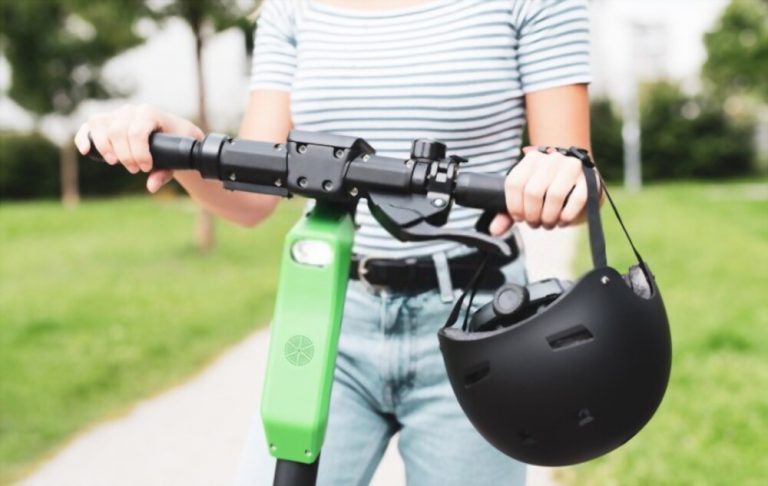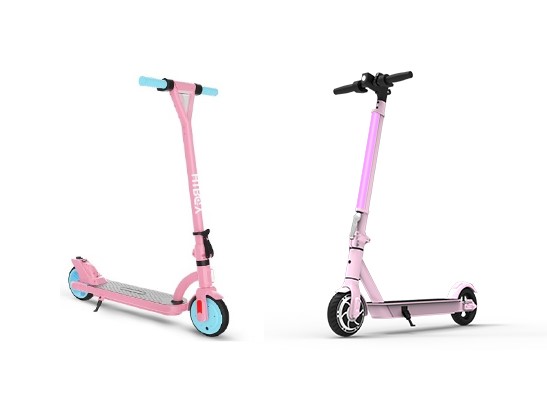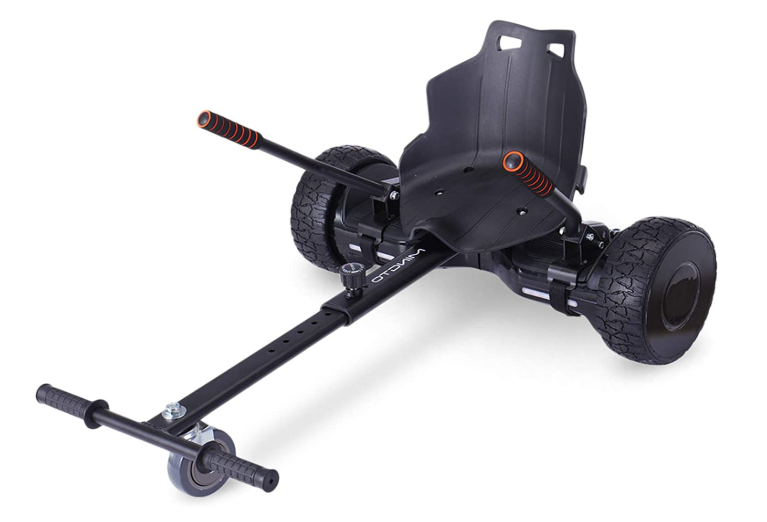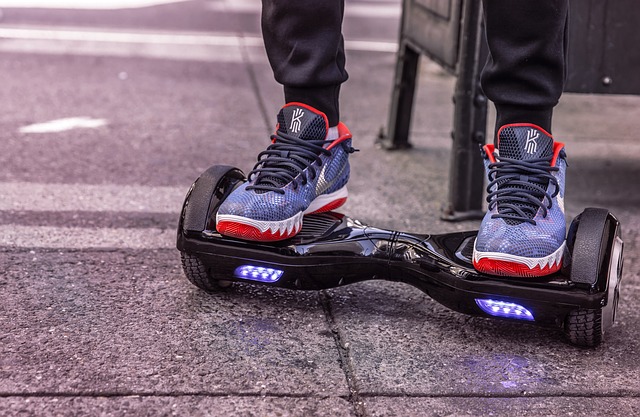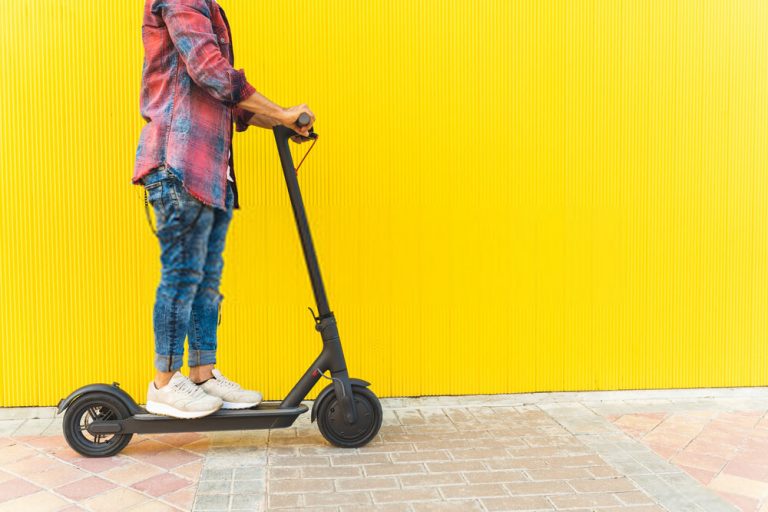Segway Ninebot S Max vs S Plus: Why S-Max is Better?
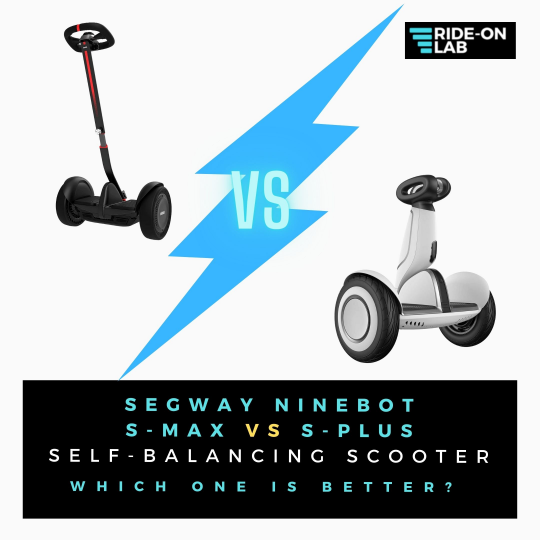
The Segway industries are well-known in the electric vehicle universe.
With both good and bad customer reviews along the way, they still manage to reach heights and surprise the world with unique new electric vehicle models.
This time, we will go into the details of two of its viral productions: the Segway Ninebot S-Max and Segway Ninebot S-Plus.
These two have both similarities and differences, and that is what makes their comparison a must.
From differences in design, motor power, range, tires, weight capacity, modes, and price to similarities in climbing angle, waterproof rating, charging time, recommended age, and warranty the Segway Ninebot S-max and the Segway Ninebot S-plus are compared in detail, below.
So let’s get started!
Related Post: Segway Ninebot S vs S Plus – Which One To Buy?
Contents
- 1 Segway Ninebot S Plus vs S Max: Specification Comparison Table
- 2 Segway Ninebot S Max vs S Plus: Major Differences
- 3 Segway Ninebot S Plus vs S Max: Quick Features Comparison
- 4 Segway Ninebot S Max: Intro Video
- 5 Segway Ninebot S Plus: Intro Video
- 6 Segway Ninebot S Max vs S Plus: Detailed Features Comparison
- 6.1 Design
- 6.2 Riding Method
- 6.3 Motor Power
- 6.4 Range
- 6.5 Top Speed
- 6.6 Battery
- 6.7 Display Console
- 6.8 Self-balancing Feature
- 6.9 Tires
- 6.10 Climbing Angle
- 6.11 Weight and Portability
- 6.12 Weight Capacity
- 6.13 Charging Time
- 6.14 Lights
- 6.15 Recommended Age
- 6.16 Safety Features
- 6.17 Bluetooth and App Compatibility
- 6.18 Remote Control
- 6.19 Seat Attachment Kit
- 6.20 Camera
- 6.21 Price
- 6.22 Waterproof
- 6.23 Customer Service
- 6.24 Modes
- 6.25 Boot Space
- 6.26 What’s Inside The Box?
- 7 Segway Ninebot S Max and S Plus Customer Reviews:
- 8 Segway Ninebot S Max vs S Plus – Which One is Better?
- 9 Segway Ninebot S Max vs S Plus: Comparison Video
- 10 Conclusion
- 11 FAQs
Segway Ninebot S Plus vs S Max: Specification Comparison Table
Segway Ninebot S Max vs S Plus: Major Differences
- Dimensions: The S Max is 20.5 inches in length, 22.8 inches in width, and 49 inches in height, while the S-Plus is comparatively shorter at 22.7 inches in length, 11.0 in width, and 24.4 inches in height.
- Steering method: The S Max features a steering column in which you can lean either left or right to steer the ride, while S-Plus has a knee bar.
- Motor power: The S-Plus is equipped with a dual 800W motor, while S-Max has a much more powerful dual 2400W motor.
- Tires: The Segway Ninebot S Max has 10-inch hollow solid tires with no treads, whereas the Segway Ninebot S-plus has 11-inch air-filled tires with treads.
- Item weight and portability: The Segway Ninebot S-Max weighs approximately 50.3 lbs (22.8 kg), so it is hard to pick but can be folded to drag it like a dolly. On the other hand, the Segway Ninebot S-plus weighs 35.9 lbs (16.3 kg), so it is comparatively lighter and has knee bar handles to pick it up easily.
- Weight carrying capacity: The weight capacity of Segway Ninebot S-Max ranges between 88 lbs. and 187 lbs., whereas the weight capacity for Segway Ninebot S-Plus is 55 lbs. to 220 lbs.
- GoKart compatibility: The Ninebot S-Max can be attached to both Ninebot GoKart and Ninebot GoKart Pro, while the S-Plus doesn’t support them.
- Auto-follow mode: The Segway Ninebot S-plus comes with a remote controller and features an “auto-follow mode,” which allows it to follow you simply with a click of its remote. In contrast, S-Max doesn’t have either of these features.
- Kickstand: The S-Max comes with a kickstand, while S-Plus doesn’t offer it.
Segway Ninebot S Plus vs S Max: Quick Features Comparison
- Sturdy & Powerful: Dual 400W motors, max speed 12.5 mph, range 22 miles, max load 220 lbs.
- Safety & Comfort: Smart Battery Management System ensures safety, extends battery life. Knee control bar for precise steering, easy lifting. 11" pneumatic tires for smooth rides on bumpy roads.
- Remote Control & Auto-Follow Mode: Use handle or joystick on multi-functional remote to control device. Activate follow mode for hands-free operation.
- This product has been tested and passed ANSI/CAN/UL-2272.
- Adventure Ready: Ninebot S MAX reaches 23.6 miles, 12.4 mph. Dual motors, 432Wh battery.
- Safety & Control: Stops on detecting unusual movements. Compact for easy trunk storage.
- Enhanced Experience: Add Gokart Kit for 23 mph speed. QR code assembly guide.
- Easy Learning: Adjust control bar height, learn via Segway-Ninebot App.
- Leansteer tech for precise response in 0.01 seconds. Smart battery management.
- Ninebot S Max is certified to UL-2272 by TUV Rheinland.
Segway Ninebot S Max: Intro Video
Segway Ninebot S Plus: Intro Video
Segway Ninebot S Max vs S Plus: Detailed Features Comparison
Design
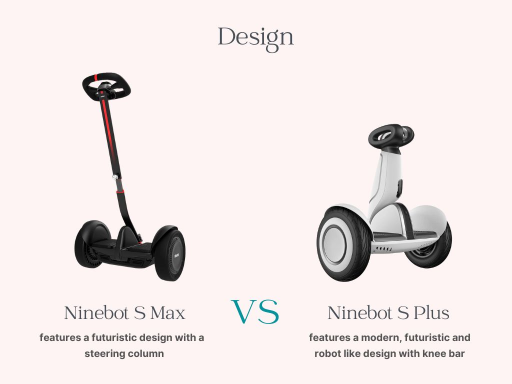
First, let’s compare these two models’ designs and overall looks.
The Segway Ninebot S Max and S plus are nothing like your regular hoverboards.
Their designs are unique and contrast with each other as well as with other ordinary hoverboards or self-balancing scooters. Both of them have a futuristic design that gives a premium feel and stylish look.
The Segway Ninebot S Max is designed like most hoverboards, with a foot pad and wheels on both sides but with the addition of a steering wheel.
This steering wheel is attached to an adjustable control bar that can be fixed at any height, but its recommended height is between 4’4″ and 6’6″.
The presence of the steering wheel provides the rider with extra control over the self-balancing scooter along with definite stability, which is difficult to have otherwise. However, if you are more comfortable in using knee-bar, you can also buy after-market knee bar control system for your S-Max.
It weighs around 50.3 lbs (22.8 kgs) and has the dimension (L x W x H) of 20.5 x 22.8 x 49 inches (unfolded) and 16.6 x 22.8 x 37.5 inches (folded).
Contrary to this, the Segway Ninebot S-plus has an innovative, eye-catching design with comparatively lesser weight (35.9 lbs (16.3 kg)) and a compact body with dimensions of 22.7 × 11.0 × 24.4 inches.
It looks more like a little robot capable of following you around thanks to its wireless connection to its remote. This feature makes it highly portable as well.
Unlike regular hoverboards, the Segway Ninebot S-plus’s middle part, known as the knee bar, is extended, making it more stable, easy to steer, and easy to ride. Unfortunately, you can’t add a steering column to your S-Plus, like the S-Max that gives you both options.
Since the designs of both these rivals are very different from each other and have their respective pros and cons, considering one above the other wouldn’t be fair.
However, crossing out the factor of ease of portability, we can give the Segway Ninebot S Max an edge over Segway Ninebot S-plus since it can provide extra stability plus comfort and facilitate the rider to ride without needing to concentrate too much.
Nevertheless, if you find both the Ninebot S-Plus and S-Max heavier and bulkier, you can go for Segway Ninebot S instead.
Buyers and testers reviews on design:
- A couple of S-Max reviewers claimed that its Steering-bar (steering column) is made from poor-quality material and not designed to hold the weight of the ride and the rider. It is highly prone to break if you fall from it or apply pressure. A few buyers broke it, too, and were disappointed to see no help from Segway’s customer care.
- The non-adjustable height of the knee bar on the Segway Ninebot S Plus makes it difficult to ride for tall riders, so buyers must consider the recommended height while buying.
- Testers of both models warned that if you lean too much, you may topple, fall, and get injured, so you must learn to ride it.
- The Segway Ninebot S Plus’s un-foldable design makes it difficult to store.
Riding Method
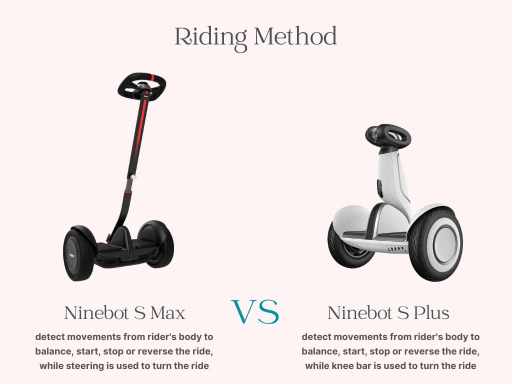
Both Segway Ninebot S Plus and S Max have slightly different riding methods.
They both feature various sensors, including a gyroscopic sensor and a tilt sensor that collaborates with microprocessors to precisely detect your body’s movement. So, the riders can easily ride these scooters with the help of their body gestures.
You can lean forward to go forward and lean backward to apply brakes, and stand upright to stop. If you continue leaning backward, you can go reverse.
However, the difference comes in turning the rides. For the Segway Ninebot S Plus, you must apply pressure with your knees on the knee bar to steer. You can push it right to turn right or left to turn left.
While the Ninebot Max features a steer-wheel that you can tilt either right or left to turn towards your tilting direction.
Buyers and testers reviews on riding method:
- 80% of the testers and riders have found both these models easy to learn and ride.
- A few claimed that you may topple over if you lean too much on Segway Ninebot S Max and S Plus.
- According to the testers, Segway Ninebot S Max is comparatively easier to handle than S Plus due to its its handlebar column.
Motor Power
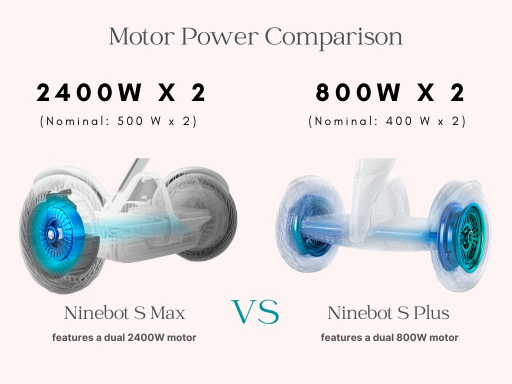
Now, in terms of motor power, the Segway Ninebot S Max is way ahead of Segway Ninebot S-plus.
For Segway Ninebot S Max, the nominal motor power is 500W x 2, and the maximum motor power is 2400W x 2. Massive, isn’t it?
As opposed to this, the Segway Ninebot S-plus has a nominal motor power of 400W x 2 and the maximum motor power of 800W x2.
This extra motor power of the Segway Ninebot S Max makes is suitable for working seamlessly with Segway Ninebot Electric GoKart Pro as well as the basic Ninebot GoKart. Besides, Max has also proven to be comparatively better at climbing hills.
Buyers and testers reviews on motor power:
- Testers wondered why S-Max is limited to 12.4 mph speed when it can perform much better with 4800W of motor power. However, a few testers came to the conclusion that it is mainly due to safety reason, as more speed will make the ride difficult to stop and handle.
- Testers confirmed that high motor power of S-Max makes it better in climbing hills.
- One of the S-Plus riders warned that if you try to get past the any obstacles on sidewalks, the ride may suddenly stops and throw you away.
- S-Plus testers claimed that this vehicle can only go up to 5 mph of speed while climbing hills.
Range
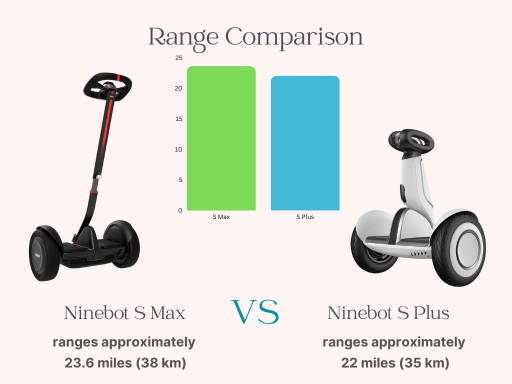
Coming to the range comparison, the Segway Ninebot S Max ranges approximately 23.6 miles (38 km).
This is slightly greater than the range of the Segway Ninebot S-Plus, which is 22 miles (35 km).
This might not seem like a lot of difference, but 3 kilometers can make a massive difference for some spending on the distance they need to travel for their workplace or school.
Buyers and testers reviews on battery life per charge:
- Many S-Plus reviewers and testers confirmed that the ride can go 20 miles on a single charge.
- Many Ninebot S Max reviewers were quite impressed with its range. However, riders with heavier weight, near to the ride’s max limit, claimed that you my get 10 to 15 miles on the single charge.
Top Speed
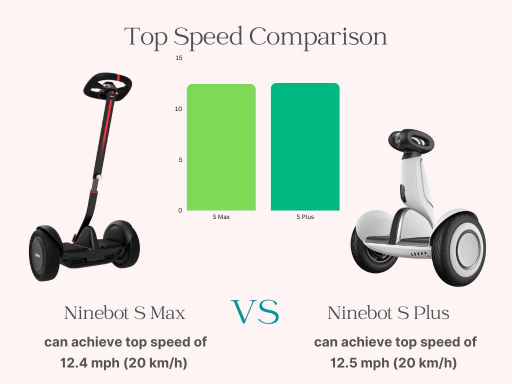
The customers need a ride that goes fast.
Most electric rides, however, have a limited speed since they run on batteries, and it also protects them from accidents as they are made of light material.
The same is true with Segway Ninebot S Max and Segway Ninebot S-Plus. They both have a very limited but approximately similar maximum speed of 12.4 mph (20 km/h).
Although S-Max has significantly higher motor power, still it has almost similar top speed as S-Plus. It is primarily due to safety, has higher speed makes the ride hard to control and stop.
Unfortunately, the similar top speed cuts this factor out of the ones that the customers can use to differentiate these two rival Segway models.
A piece of advice, though, is that this maximum speed might gradually decrease over the years along with the range as the battery efficiency decreases, so change the battery once you feel like it is not catching up to your needs.
Buyers and testers reviews on top speed:
- Testers and reviewers for both of these Segway models confirmed that these rides could achieve their top speed as claimed by the manufacturer. However, a few testers pointed out a horrific bug in the S-Max scooter’s programming that suddenly applies the brakes (as a safety feature) when the rider tries to exceed the speed limit. This, as a result, topples the rider and causes the accident. Later, a few reviewers confirmed that Segway had fixed this issue.
Battery
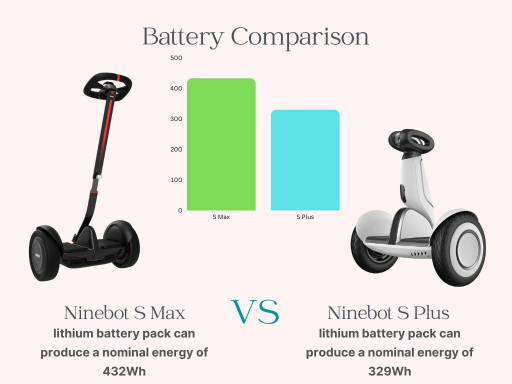
With overheating protection, the high-quality Segway Ninebot S-MAX lithium battery pack can produce a nominal energy of 432Wh.
On the other hand, the Segway Ninebot S-plus battery pack has a lesser nominal capacity than the Segway Ninebot S max of 329Wh. It also has overheating protection.
Greater battery power, in turn, allows a greater range and speed, which puts Segway Ninebot S Max ahead of Segway Ninebot S-Plus.
However, It is disappointing to see, that batteries for both these models are difficult to replace, so they can only be replaced by the manufacturer.
Buyers and testers reviews on battery:
- A bunch of S-Max and S-Plus buyers complained about faulty batteries. Some claimed that battery stopped charging after a few cycles, while other claimed it discharged to quickly, and failed to charge again.
Display Console
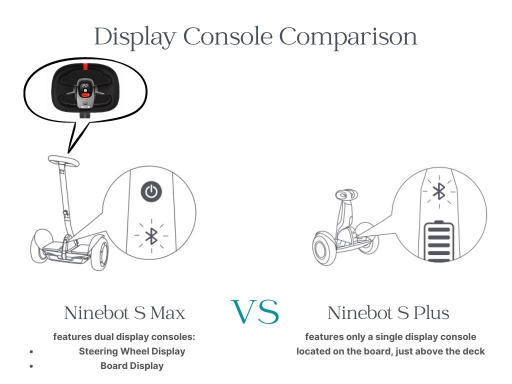
Most electric scooters now come with a display console to display essential information. So is the Segway Ninebot S Plus and S Max.
The Ninebot S Plus has a LED display above the deck on its middle bar. The console features a physical power button to turn the on/off the vehicle, while the display shows a lock, Bluetooth, speed limit, and battery level indicator.
Fortunately, The Segway Ninebot S Max has two display consoles. The first is the same display console as S-Plus, located at a similar place, and shows the same information. The other one is on the center of the steering wheel, which features a speedometer, Bluetooth, and battery level indicator.
The steering wheel also has a toggle button, rest button, and AAA battery holder to add batteries that power up the control panel (aka display console on the steering wheel).
Self-balancing Feature
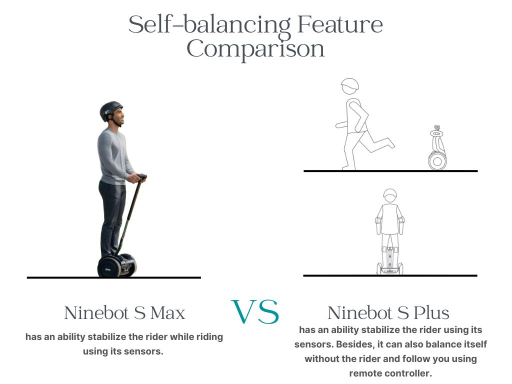
Both, the Ninebot S-Plus and the S-Max models, are equipped with various sensors, including a gyroscopic sensor and a tilt sensor that collaborates with microprocessors to precisely detect your body’s movement and balance the ride accordingly to keep the rider stable while riding.
The self-balancing feature of the Segway Ninebot S-Max is better than most hoverboards due to the presence of a steering wheel which eases the rider’s control over the vehicle.
It also has 0.01-second sensitivity, which means it will detect any movement within this time and respond accordingly.
The self-balancing feature of the Segway Ninebot S-Plus is so good that it can even move around without the rider simply on the order of its remote.
It gives the impression of a mini robot walking around following you.
The self-balancing feature of both these models is up to the mark but the Segway Ninebot S-Plus is a few steps ahead of its rival since it can even balance itself and move around without needing a rider.
Buyers and testers reviews on self-balancing feature:
- 95% of the reviewers were amazed with the self-balancing feature of both these models. They found it easy to learn, and operate. Besides, they also confirmed that self-balancing feature is reliable. However, a few S-Max users claimed that self-balancing feature stopped working a few month of usage.
Tires
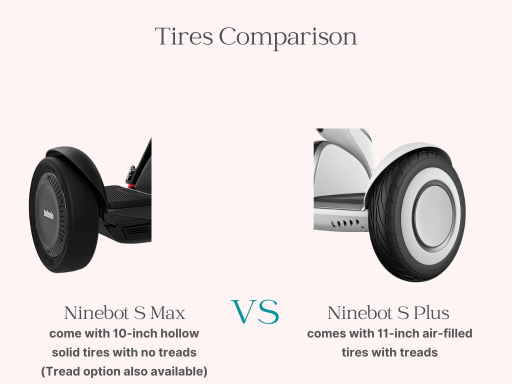
The Segway Ninebot S Max has 10-inch hollow solid tires with no treads in comparison to Segway Ninebot S-plus, which has 11-inch air-filled tires with treads.
Air-filled tires can more easily travel over a rugged landscape as compared to solid tires, but solid tires have the advantage of not going flat, but they have a lesser grip on roads compared to air-filled tires.
So, now you must be thinking that S-Max must be horrible in grip as it has solid tires with no treads!
That is not totally true! Actually, hollow technology, along with the heavy weight of the machine and the riders, provides enough grip. However, not as much as the treaded pneumatic tires. So, S-Plus will give you comparatively better stability and traction on roads for regular use.
Actually, this “no-grip” feature was introduced in S-Max to enhance the drifting experience when attached to Segway Ninobot Go-kart Pro. So, if you want Ninebot S-Max for regular commuting, you must buy after-market tires with treads.
Since both types of tires have their own advantages and disadvantages, we will give Segway Ninebot S-plus an edge since it has an inch bigger tires with better grip than the Segway Ninebot S Max.
Buyers and testers reviews on tires:
- One of the S-Max users had to buy tires with treads to prevent the ride from slipping on bumps during regular use.
- Like all other air-filled tires, S-Plus’s tires are comfortable and offer high traction. However, riders did face flat tire issues.
- Riders were a bit disappointed with Segway’s customer service. They complained that replacement tires were “out of stock” for a long time, and the company’s strict warranty policy stopped them from buying third-party tires, making the scooter useless.
Climbing Angle
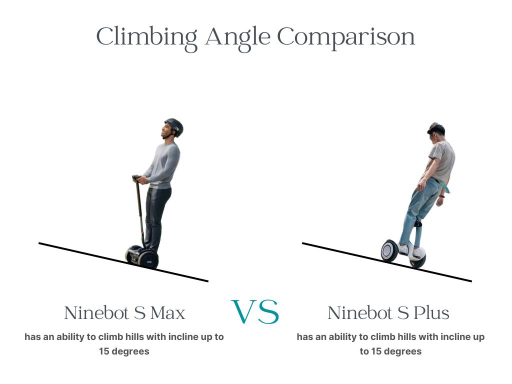
Both Segway Ninebot S-max and Segway Ninebot S-plus have an approximate climbing angle of 15 degrees.
This means that both of these hoverboards can climb a little height but cannot move up extremely steep hills. In comparison, Segway Ninebot S-Max would perform better at climbing hills due to its more powerful motor.
If you live in a hilly area with many slopes, you better think again if you want these hoverboards.
Buyers and testers reviews on hill incline:
- Testers recommended to avoid steep hill, while riding on normal hill (below 15 degrees incline) is manageable.
- Riders were afraid to ride these self-balancing scooters down the hill.
Weight and Portability
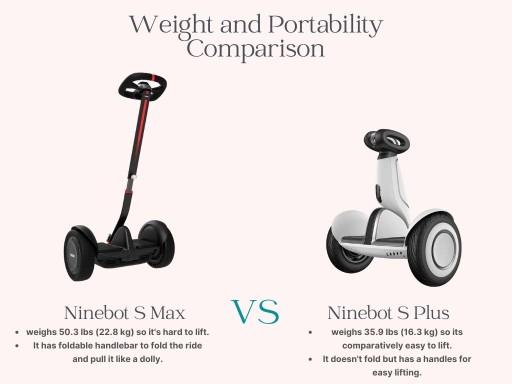
The weight of the hoverboard defines its portability.
The Segway Ninebot S-Max weighs approximately 50.3 lbs (22.8 kg) while on the other hand, the Segway Ninebot S-plus weighs 35.9 lbs (16.3 kg) which is clearly a lot less than Segway Ninebot S-Max.
This less weight of the Segway Ninebot S-Plus increases its portability since it would be easier to pick it up, even up the stairs using knee-bar as an handle.
On the other hand, S-Max’s steering column can be folded to easily drag the scooter like a dolly. However, dragging it or picking it up the stairs can be difficult.
Buyers and testers reviews on portability:
- The S-Max quite heavy to pick, but steering column makes it easy to drag atleast” many testers stated.
- Users find the S-Plus quite easy to lift and carry it behind the trunk. Besides, its auto-follow mode further help the users to keep the ride along without lifting.
Weight Capacity
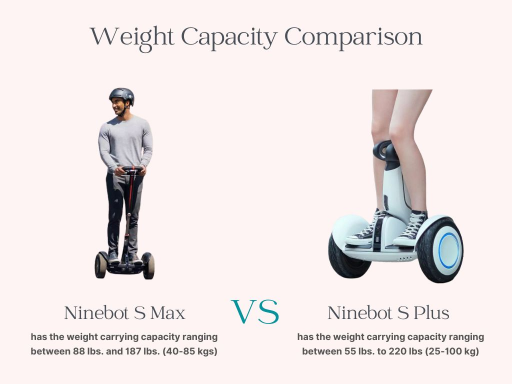
The weight capacity of Segway Ninebot S-Max ranges between 88 lbs. and 187 lbs. (40-85 kgs), whereas the weight capacity for Segway Ninebot S-Plus is 55 lbs. to 220 lbs (25-100 kg).
It is crystal clear that Segway Ninebot S-Plus has a greater weight range than the Segway Ninebot S-Max.
A person as thin as 25 kgs, typically a kid, or someone overweight as in 100 kgs, can easily ride the Segway Ninebot S-plus, which makes it a good choice for the entire family. Anyone would be able to ride it.
Although, you can slightly push these limits, but you have to compromise with the advertised range, and top speed.
The issue that comes with the weight capacity is that if a person weighing less than the minimum weight capacity rides the self-balancing hoverboard, then the hoverboard won’t even start, and when someone crossing the maximum weight limit rides it, it gradually damages the hoverboard.
Regularly riding over the maximum weight capacity is like a slow poison to your hoverboard since its sensors will decrease efficiency, and there is a possibility of overheating and damage to the inner wiring.
We have not even considered its disastrous effect on the hoverboard’s battery and motor power.
All these possibilities combined are a reminder for you to stay within the weight limit when you ride the hoverboard.
Buyers and testers reviews on weight capacity:
- Many Segway Ninebot S-Max reviewers have claimed to ride it without any issue, even with their weight significantly exceeding the advertised weight limit. They were glad to find this vehicle amazingly durable and powerful.
- Segway Ninebot S Plus user were also overall satisfied with the scooter’s performance while staying under its stated load bearing capacity.
Charging Time
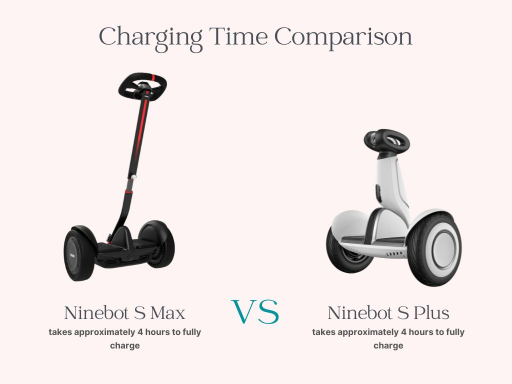
For the Segway Ninebot S Max, the charging time is approximately 4 hours which is similar to the charging time of the Segway Ninebot S Plus, which is also 4 hours.
The equal charging time suggests that 4 hours is the average charging time for most hoverboard batteries.
This also means that since the charging time is the same, other factors need to be considered when selecting the hoverboard that meets your requirements.
Buyers and testers reviews on charging time:
- A bunch of reviewers for both these models faced charging issues, where the ride didn’t turned on after even all night charging, while a few claimed that the battery stopped charging.
Lights

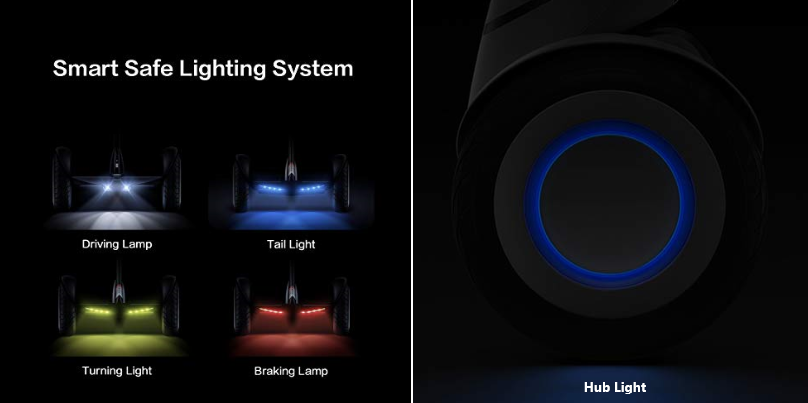
The Segway Ninebot S-Max has front and rear LED lights (ambient only) which help you see the road ahead clearly in the dark. It is also possible to customize the rear lights on it.
The Segway Ninebot S-plus has a safe and smart lighting system. The lights on this hoverboard are adjustable and ambient. They are on the front, the wheels, and the rear horizontal area. The front lights glow the most and are reliable. Whereas, the rear lights are smart and detects the vehicle’s movement to act as a turning indicator and braking light.
Since the Segway Ninebot S-Max does not have lighting around the wheels as well as no turning lights or brake lights, it is an edge behind the Segway Ninebot S-Plus. The rest of their apparent lighting system is almost similar.
Buyers and testers reviews on lighting:
- Riders of both these models fell in love with their lighting systems. However, Ninebot Gokart users wished S-Max had brakes lights and turning lights as a safety feature.
Recommended Age
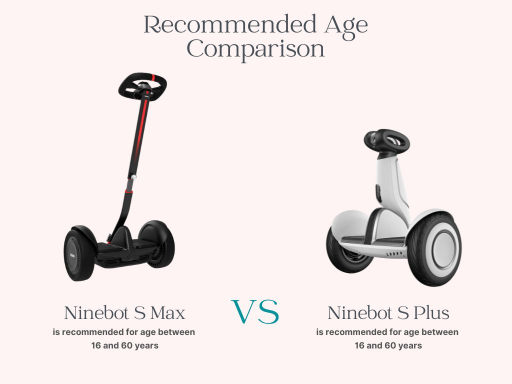
Age 16-60 is the recommended age for both the Segway Ninebot S-Max and Segway Ninebot S-plus, which means teenage and adults, both age groups, can easily ride both of these Segway models.
Buyers and testers reviews on age range:
- Testers and reviewers highly recommended abiding by the recommended age, as a few riders are above the max. age have fallen while riding and got injured. This is due to a lack of balance after you cross 60 years of age.
Safety Features
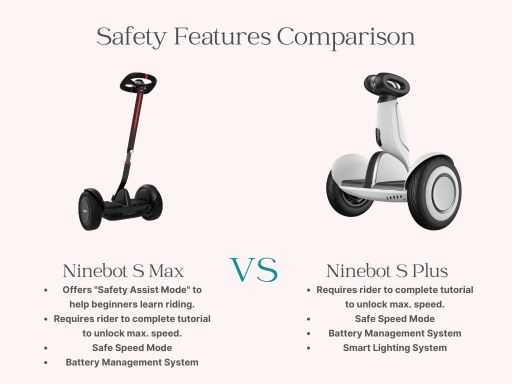
The Segway Ninebot S-Max comes with a Safety Assist Mode, which will assist you until you get the gist of how to ride it safely on your own manually. This safety is a much-needed feature for beginners. Besides, it has headlights and taillights for safe riding in the dark.
On the other hand, The Segway Ninebot S-Plus does not have a safe mode, but it does not need one since it can balance perfectly fine even without a rider. However, it does have a tutorial mode that riders must complete to unlock the maximum speed.
Moreover, S-Plus is also equipped with an intelligent lighting system that turns the rear lights into turning light, brake light, as well as an ambient light for safe riding on the road. Unfortunately, the rear lights of S-Max are not smart and can only be used as ambient lights.
Talking about the common features, both these models can detect unusual movements like falling, lifting, or over-speeding. The engine is automatically turned off to protect the ride and the rider from injury or accident.
Another safety feature that both models include is Battery Management Systems (BMS) that keep the battery safe. The BMS offers protection against over- and under-voltage, short circuits, and overheating. Besides, they also have the auto-sleep and auto-wake functions to save battery.
Buyers and testers reviews on its safety:
- Buyers were satisfied with both models’ quality, build, and safety features. However, a few did show some concerns.
- Some S-Plus reviewers complained about the “unusual movement detecting safety feature,” which malfunctions while climbing or going down the hills. The ride suddenly stops on inclines and causes the rider to fall. However, this issue was later fixed by Segway.
- A few S-Max riders complained about its “auto-slow down” safety features, which suddenly cause the ride to stop if its speed exceeds the limit. Consequently, causing the rider to fall. The users suggested that Segway should fix the issue by reprogramming the safety feature to gradually slow down the speed instead of applying sudden dead-stop brakes.
Bluetooth and App Compatibility
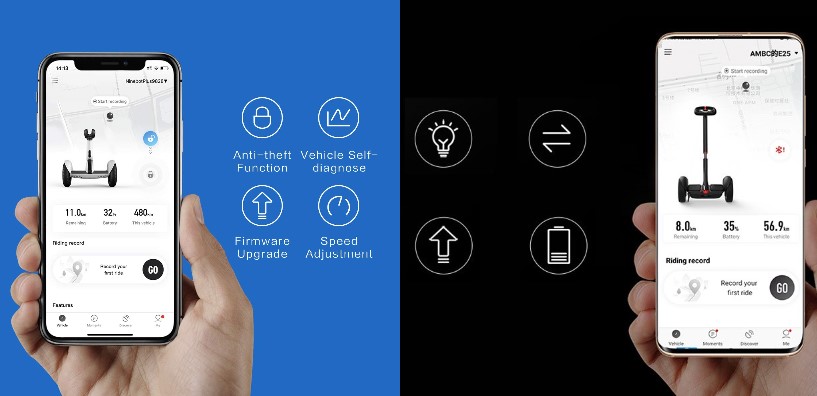
The Segway Ninebot S-max and the Segway Ninebot S-plus both include Bluetooth features.
This helps them connect directly to the Segway app, which allows the user to perform various function just with the tap of a finger, including:
- Control the speed
- Anti-theft feature to lock the ride
- Vehicle self-diagnosis
- Firmware Upgrade
- Adjust rear ambient lights
- Speed, Battery, Range status
Buyers and testers reviews on Bluetooth and App Support:
- Almost all reviewers and testers were glad to Bluetooth and App support. Besides, they also loved the App quality provided by the Segway.
- One of the tester noticed that “Anti-theft lock” feature only works until it is within the range of the remote control or Bluetooth of mobile device.
- One of the S-Plus user was frustrated to see that riders have to complete the tutorial tasks to unlock the speed, else it will keep on repeating.
Remote Control
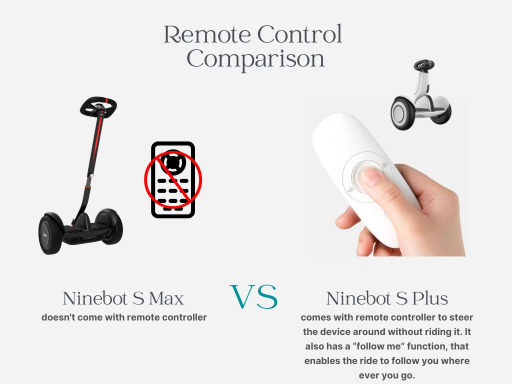
Even though this is a similarity between the two rivals, the Segway Ninebot S-plus has the additional feature of following the orders of a remote.
The remote is placed inside a secret box on the knee bar, that you can easily take it out by removing the cover.
You can use the remote’s joystick to steer the device around without riding it. It also has a “follow me” function, that enables you to control it simply by sitting around in your house or your workplace with the push of a button and see it moving around following you!
This remote feature can also be used to operate Segway Ninebot S-Plus as a drone camera. The S-Plus’s knee bar has a camera holder to install a camera, and you can use the remote to move the device around to record the fun moments.
Unfortunately, this remote control doesn’t come with the S-Max.
Buyers and testers reviews on remote control:
- Testers warned that to control the S-Plus safely using the remote control, you must ensure the the device must stay within its range. If the ride gets out of range while operating, it gets out of control.
Seat Attachment Kit
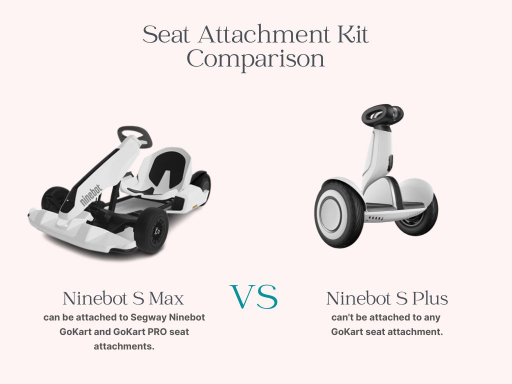
The Segway Ninebot S Max has an adventurous addition that you can make to it. You can add your hoverboard to this GoKart and have a more thrilling ride at a higher speed.
The Ninebot S-Max can be attached to both Ninebot GoKart and Ninebot GoKart Pro.
On the other hand, the Segway Ninebot S-Plus doesn’t have any such addition nor a seat for your comfort. It does have one feature of following you around at the control of a remote, but that is not enough for one’s comfort or thrill like the addition of a GoKart is.
However, you will need to pay a lot more for the GoKart but not for the robotic Segway Ninebot S-Plus following you.
But since the GoKart is a whole different experience, we will give this point to Segway Ninebot S-Max.
Buyers and testers reviews on seat attachment kit:
- Reviewers loved the S-Max’s compatibility with Ninebot GoKart and wished S-Plus had the same feature. However, a few did complain about the poor customer support for GoKart-related issues.
Camera
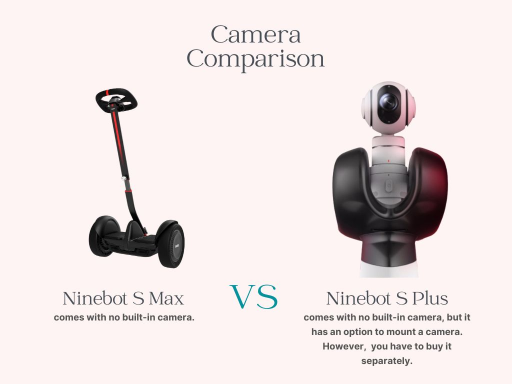
None of the two, the Segway Ninebot S-Plus or S-Max, have the built-in camera feature. However, you can add an after-market camera to your Segway Ninebot S Plus and operate it like a drone using the remote controller.
Buyers and testers reviews on camera:
- Reviewers were disappointed to see Segway no longer selling camera for S-Plus. Therefore, customers have to buy it from other sources.
Price
The Segway S-Max is slightly higher in price (you have to pay around $250 extra) compared to the Segway Ninebot S-Plus, which is a negative point, as you get comparatively fewer features but significantly higher power with high price.
Now it’s up to you to decide if you would rather go for a high price and high power or better features.
Buyers and testers reviews on price:
- Half of the total reviewers were overall satisfied with both the products’ value for money, while the other half found it a bit expensive or were disappointed with the product’s quality and customer service.
Waterproof
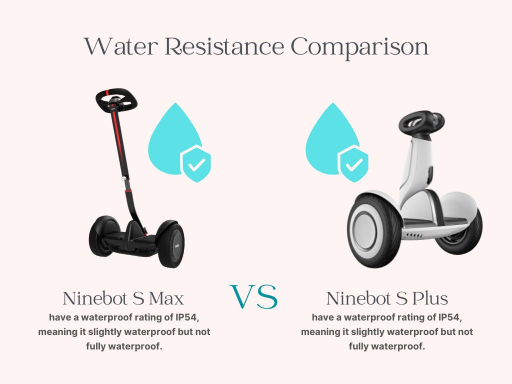
The Segway Ninebot S-Plus and Segway Ninebot S-Max have a waterproof rating of IP54, meaning they are both slightly waterproof but not fully waterproof.
Buyers and testers reviews on waterproofing:
- Testers warned they may survive slight water sprinkles but would get damaged if exposed to excessive amounts of water since electricity and water don’t go well together, and we know that both are electric vehicles.
Customer Service

For both Segway Ninebot S-Plus and S-Max, the Segway company has the same policies.
The return policy includes returning the defective piece in the same packaging, unused, and paying the shipping cost yourself within 30 days of receiving the product.
The warranty includes different warranty days for different parts, such as 12 months for vehicle body components and 180 days for other components like chargers and battery assembly.
Buyers and testers reviews on customer service:
- According to most reviews, Segway Customer Service is very disappointing. They won’t bother to help their customers and try to solve all possible under their full attention to the subject.
Modes
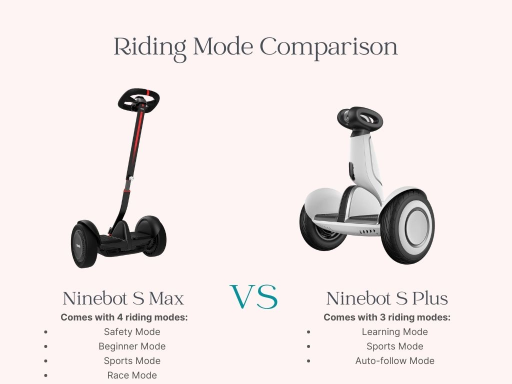
The Segway Ninebot S-Max has four types of modes.
One is the safety mode makes this vehicle run at 4.97 mph.
The second mode is the beginner mode, and the Segway Ninebot S-max runs at 11.2 mph in this mode.
Next comes the sports mode (speed: 17.4 mph) and the race mode (speed: 23 mph). These last two modes are unlocked when you complete the learning tutorials on the Segway Ninebot S-Max.
In contrast, the Segway Ninebot S Plus only has a slow mode (learning mode) and a sports mode. To unlock the sports mode, you need to complete the tutorial.
Besides, the Auto-follow mode of the Segway Ninebot S-plus allows it to follow you simply with a click of its remote.
Buyers and testers reviews on modes:
- Users of both these models found their tutorial mode quite frustrating to complete, as you have to start all over again if you miss completing the tutorial on one go.
- Reviewers and testers were overall satisfied with the riding modes these models offer. Specifically, they appreciated the auto-follow mode offered by S-plus that makes the device stand out.
Boot Space
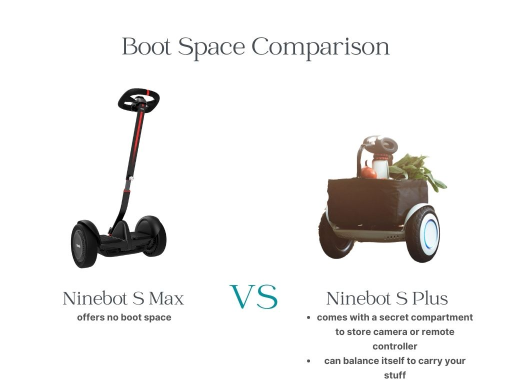
The Segway Ninebot S-Plus has a built-in boot space hidden under the vehicle’s knee bar cover.
You must press the button to unlock the cover and pull off the lid. To close the cover, you need to insert the bottom first and press the upper side until the click sound.
This storage compartment can carry a remote controller (which comes inside the box) and a camera (you have to buy it separately). Both of these can be secured to their place by a built-in retaining strap.
On top of that, The S-Plus’s self-balancing features enables it to easily carry your stuff and follow you! You can simply put on the basket full of stuff on it and enable the “follow” mode.
Unfortunately, Segway Ninebot S Max doesn’t have any boot space.
Buyers and testers reviews on boot space:
- One of the reviewers complained that “the storage compartment of Segway Ninebot S Plus doesn’t offer much space to store anything, except the keys”.
What’s Inside The Box?
The Segway Ninebot S Plus comes with:
- Steering bar (knee bar)
- Mainframe
- Accessory box containing screws, cap, valve stem extension, Hex wrench, remote controller, USB charger cord and Charger
- User manual
- Limited warranty card
The Segway Ninebot S Max comes with:
- LeanSteer
- Frame
- Steering wheel
- Control panel
- User Manual
- Limited warranty card
- Gokart Assembly Tool Kit containing open-end wrench, 3 mm Hex wrench, and straps
- M4 and M5 screws
- 4 mm and 2.5 mm hex wrench
- AAA batteries
- Flange
- Cap
Segway Ninebot S Max and S Plus Customer Reviews:
Positive
According to one customer, the Segway Ninebot S-Max can climb up 20 degrees uphill even though the company claims that it can only go up to 15 degrees.
A customer suggested that the Segway Ninebot S-plus was perfect in terms of achieving fitness as you need to use your muscles (not tiringly but with ease) to ride this hoverboard.
Negative
On Segway Ninebot S-max, a customer claimed that they bought 6 pieces around Christmas time, and all of those stopped working by February, which means that they only lasted around three months.
About the Segway Ninebot S-plus, a customer did not like how the speed wouldn’t go up 11 mph and how it starts to push back at around 10 mph.
Segway Ninebot S Max vs S Plus – Which One is Better?
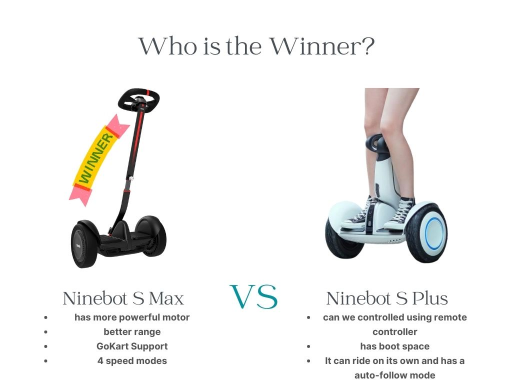
With a more comfortable design, including a steering wheel for ease, a more powerful motor and battery along with greater range, the Segway Ninebot S-Max is an apparently better choice than the Segway Ninebot S-Plus.
As if to counteract its rival, the Segway Ninebot S-Plus comes with its own unique features of enhanced portability, such as the miraculously robotic self-balancing feature that allows it to follow you around. It weighs less itself but has the capacity to carry more weight than Segway Ninebot S-Max.
It also has slightly bigger but better grip air-filled tires with a lighting system a step ahead of the Segway Ninebot S-Max.
The Segway Ninebot S-Max wasn’t planning to stay behind and give in to this counter-attack by the Segway Ninebot S-Plus, so it came up with a much more attractive addition GoKart.
You might not feel that other differences between these two are distinctive, but you can’t deny that the GoKart is an eye-turner, an extremely exclusive addition to the world of hoverboards.
Other factors, such as waterproof rating, customer support, climbing angle, and charging time, are similar for both of these models.
With careful comparison, we decide that the Segway Ninebot S-Max is the overall winner with better-required features, better range and GoKart support. However, Ninebot S-Plus isn’t far behind.
Segway Ninebot S Max vs S Plus: Comparison Video
Conclusion
A clear-cut detailed comparison of the Segway Ninebot S-max and Segway Ninebot S-plus with all of their basic features like charging time, range, top speed, and weight capacity discussed must have given you an idea of what you want.
In conclusion, both the Segway Ninebot S-max and Segway Ninebot S-plus have their own eccentric qualities, and one cannot be swapped for another one, but it all depends on you to choose the one that you find is better in your case.
Explore more on Segway:
- Best Segways for Kids, Teens & Adults
- Segway Ninebot MAX Electric Kick Scooter Review
- Segway Ninebot ES2 vs ES4 Electric Kick Scooter: Why Ninebot ES4 is better?
- Hiboy S2 Max vs Segway Ninebot Max – Why Choose Segway?




